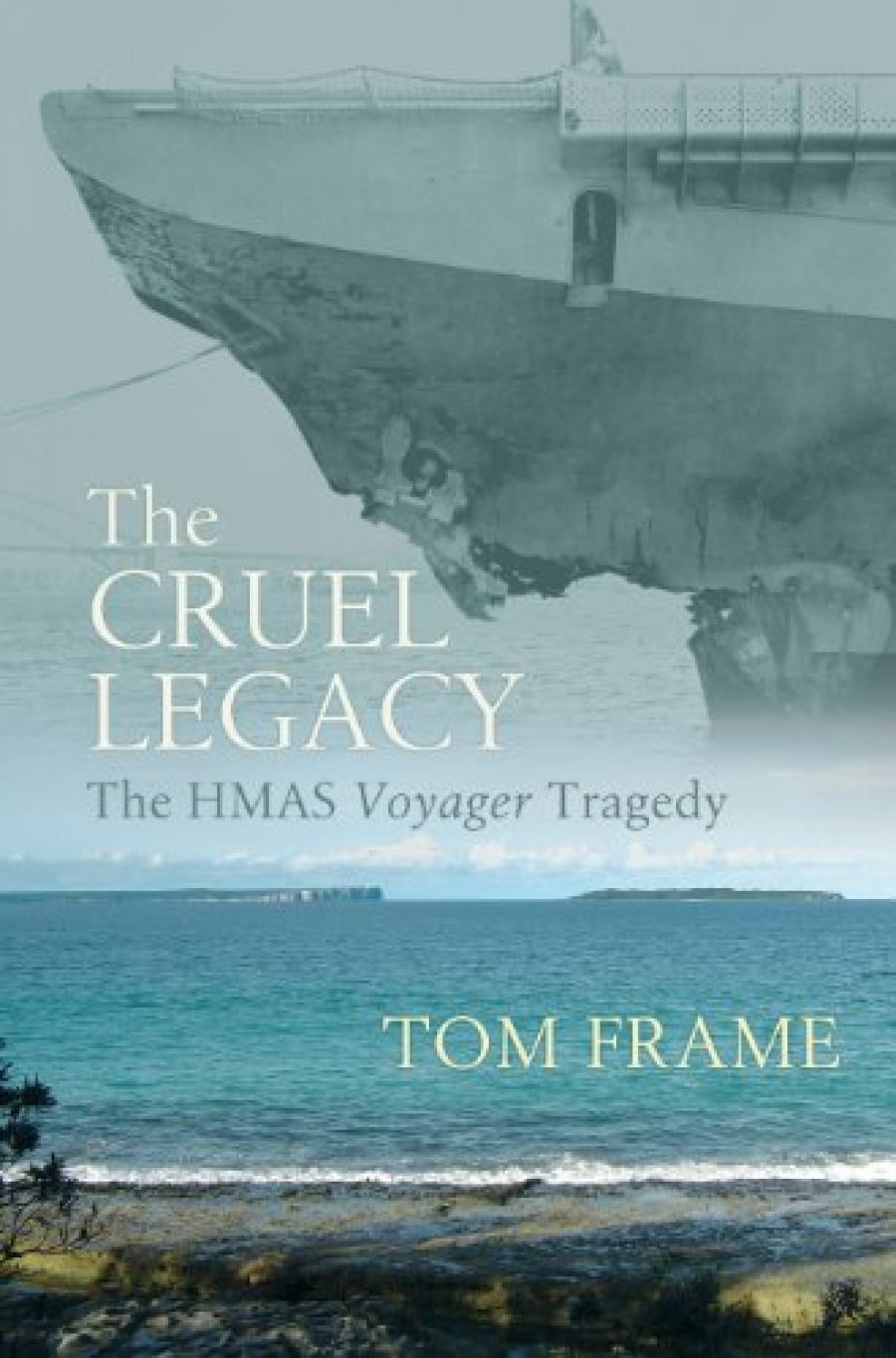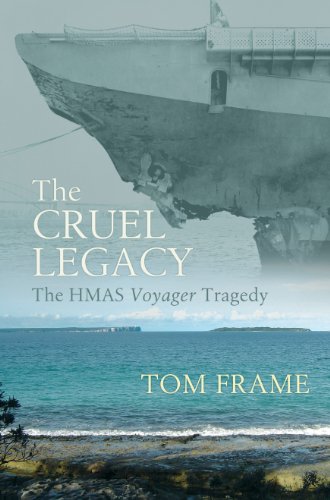
- Free Article: No
- Contents Category: Military History
- Review Article: Yes
- Article Title: Late answers
- Online Only: No
- Custom Highlight Text:
When I first heard that Tom Frame’s latest book was about the Voyager disaster, I wondered if the author had come down with amnesia, for he had already published a book on this subject thirteen years ago. However, if the federal government required two royal commissions to come to a conclusion about this naval accident, it is surely appropriate that Frame, having written Where Fate Calls: The HMAS Voyager Tragedy, should write a second book – The Cruel Legacy: The HMAS Voyager Tragedy – to revisit and reconsider this complex and controversial event.
- Book 1 Title: The Cruel Legacy
- Book 1 Subtitle: The HMAS Voyager tragedy
- Book 1 Biblio: Allen & Unwin, $29.95pb, 235pp, 1 74114 421 3
- Book 1 Cover Small (400 x 600):

- Book 1 Cover (800 x 1200):

On 10 February 1964 the destroyer Voyager collided with the much larger aircraft carrier Melbourne during night exercises. Melbourne sliced Voyager in half, causing the death of eighty-two of Voyager’s crew. This remains Australia’s worst peacetime naval disaster.
The navy’s senior officers were slow to realise that the scale of this incident would place the navy under the intense scrutiny of government, media and public. The Naval Board was taken aback when Prime Minister Robert Menzies called a royal commission rather than allow an internal naval inquiry. The Melbourne’s captain, John Robertson, foolishly entered the adversarial environment of the royal commission without legal counsel and found himself criticised in the commissioner’s report. Robertson tendered his resignation. The Naval Board was anxious to move on from the incident, but others would not forget Voyager so easily. Recruiting dropped, sailors refused to re-engage when they completed their term of service, and, most importantly, Liberal backbencher John Jess took up the case of Robertson, who had been ruled ineligible for a naval pension. In 1967 Harold Holt, the new prime minister, was forced to order a second royal commission to take account of new allegations that Voyager’s captain, Duncan Stevens (who had died in the collision) had a drinking problem.
While the second inquiry found that Stevens’ drinking had not contributed to the accident, it concluded that Voyager had caused the accident. In 1968 the government gave Robertson an ex gratia payment. The following year, Melbourne collided with the US destroyer Frank E. Evans, with the loss of seventy-four lives. The Melbourne gained the reputation for being jinxed, but both times the smaller ship was at fault.
This book is much better than Frame’s first attempt at the subject. Where Fate Calls remained close to its origin as a PhD thesis and was really two books in one: the first being the story of the collision, the second a study of the 1960s navy as a closed institution. The Cruel Legacy is half the length of Where Fate Calls, is more focused on Voyager and includes corrections of the original work.
The most significant addition in this book is Frame’s account of the 1990s court cases claiming Post Traumatic Stress Disorder (PTSD) arising from the collision. Frame opposes these actions arguing that they harm the claimants more than help them. He describes PTSD as ‘a scientifically contested condition’, and argues that the psychological effects of the collision cannot be blamed for every subsequent ‘misfortune and anxiety’. Having once given evidence as an expert witness in a case where a man was awarded damages for PTSD arising from the collision, Frame has refused to appear in any subsequent trials and has destroyed all his papers relating to the disaster so that he cannot be compelled to provide documents for any future cases.
The efficacy of legal action might be questioned, but what cannot be doubted is that official inaction and obstruction prevented any appreciation of the psychological effects of the collision for decades. The Naval Board in 1964 decided not to order psychological assessment of the Voyager survivors, arguing that the sailors were ‘sufficiently and temperamentally robust’ to be unaffected and, at the same time, were so suggestible that carrying out assessments ‘might well implant ideas of such disabilities’. Service personnel could not sue the Commonwealth until a 1982 High Court ruling, and it was not until 1983 that a court decided in favour of a collision survivor. When the Commonwealth multiplied the size of this damages award by the number of possible Voyager claimants, they invoked the statute of limitations to prevent further cases. In 1990 the High Court struck this down, the government instituted a scheme to deal with Voyager claims, and sailors who had been serving in Melbourne began making claims. No one on board Melbourne was killed or injured in the collision, but the navy in 1964 did not even consider the necessity to carry out psychological assessments of the aircraft carrier’s crew.
Litigation is never the entire answer, but it should not be discounted as being a part of the process of recognition, affirmation and healing for these men, who, as Frame writes, ‘have faced death and lived to see a new day’.


Comments powered by CComment